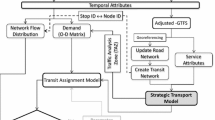Abstract
Automated fare collection (AFC) systems such as smart cards are becoming increasingly popular among transit agencies worldwide. Two main configurations of AFC systems can be found, characterized by whether users are required to scan their cards at the beginning of their trips (i.e., entry-only system) or both at the beginning and end of their trips (i.e., entry–exit system). Recently, there has been growing interest in implementing the latter configuration in order to provide more equitable fare structures that charge users based on distance, while arguably providing more accurate data for an origin-destination analysis of users. Therefore, this study explores the spatial and temporal differences in transit users’ origin-destination estimations that are based on the two AFC system configurations. To achieve this goal, it uses AFC system data collected from GO Transit, the operator of the regional commuter rail and bus systems in the Greater Toronto and Hamilton Area (GTHA). A comprehensive model was developed which suggests that the entry–exit AFC system configuration helps in estimating about 14% more trips than an entry-only AFC system configuration; the latter uses a set of common assumptions that are normally employed by researchers in estimating users’ destinations. Spatial, temporal and mode related differences between the two system estimations were also found. This paper offers policy makers and planners a better understanding of the possible benefits/impacts of implementing entry–exit systems vs. entry-only systems on transit users’ origin-destination estimations.











Similar content being viewed by others
References
Attoh-Okine N, Shen L (1995) Security issues of emerging smart cards fare collection application in mass transit. Paper presented at the Vehicle Navigation and Information Systems Conference, 1995. Proceedings. In conjunction with the Pacific Rim TransTech Conference. 6th International VNIS. 'A Ride into the Future'
Barry J, Newhouser R, Rahbee A, Sayeda S (2002) Origin and destination estimation in New York City with automated fare system data. Transp Res Rec 1817:183–187. https://doi.org/10.3141/1817-24
Barry J, Freimer R, Slavin H (2009) Use of entry-only automatic fare collection data to estimate linked transit trips in New York City. Transp Res Rec 2112:53–61. https://doi.org/10.3141/2112-07
Covic F, Voß S (2019) Interoperable smart card data management in public mass transit. Public Transp 11(3):523–548. https://doi.org/10.1007/s12469-019-00216-x
Devillaine F, Munizaga M, Trépanier M (2012) Detection of activities of public transport users by analyzing smart card data. Transp Res Rec 2276(1):48–55. https://doi.org/10.3141/2276-06
Fleishman D (2003) Fare policies, structures and technologies: update (0309087643), Washington, D.C. http://onlinepubs.trb.org/onlinepubs/tcrp/tcrp_rpt_94.pdf
GO Transit (2017a) Fare information. https://www.gotransit.com/en/trip-planning/fares/fares
GO Transit (2017b) GO Transit: Fact Sheet, Toronto, Canada
GO Transit (2018) GO Transit: Fact Sheet, Toronto, Canada
Iseki H, Yoh A, Taylor B (2006) Survey on status of knowledge and interest of smartcard fare collection systems among US transit agencies, Los Angeles
Li H, Chen X (2016) Unifying time reference of smart card data using dynamic time warping. Procedia Eng 137:513–522. https://doi.org/10.1016/j.proeng.2016.01.287
Li D, Lin Y, Zhao X, Song H, Zou N (2011) Estimating a transit passenger trip origin-destination matrix using automatic fare collection system. Paper presented at the international conference on database systems for advanced applications, Berlin
Metrolinx (2008) The big move: transforming transportation in the Greater Toronto and Hamilton Area, Toronto, Canada
Metrolinx (2013) GO transit rail parking and station access plan. http://www.metrolinx.com/en/regionalplanning/projectevaluation/studies/GO_Transit_Rail_Parking_and_Station_Access_Plan_EN.pdf
Multisystems, Mundle and Associates, S. S. R. Associates (2003) Fare policies, structures and technologies: update, Washington
Munizaga M, Palma C (2012) Estimation of a disaggregate multimodal public transport Origin-Destination matrix from passive smartcard data from Santiago, Chile. Transp Res C 24:9–18. https://doi.org/10.1016/j.trc.2012.01.007
Munizaga M, Devillaine F, Navarrete C, Silva D (2014) Validating travel behavior estimated from smartcard data. Transp Res C 44:70–79. https://doi.org/10.1016/j.trc.2014.03.008
Nunes A, Dias T, Cunha J (2016) Passenger journey destination estimation from automated fare collection system data using spatial validation. IEEE Trans Intell Transp Syst 17(1):133–142. https://doi.org/10.1109/TITS.2015.2464335
Park J, Kim D, Lim Y (2008) Use of smart card data to define public transit use in Seoul, South Korea. Transp Res Rec 2063(1):3–9. https://doi.org/10.3141/2063-01
Pelletier M, Trepanier M, Morency C (2011) Smart card data in public transit planning: a review. Transp Res C 19(4):557–568. https://doi.org/10.1016/j.trc.2010.12.003
Reddy A, Lu A, Kumar S, Bashmakov V, Rudenko S (2009) Entry-only automated fare-collection system data used to infer ridership, rider destinations, unlinked trips, and passenger miles. Transp Res Rec 2110:128–136. https://doi.org/10.3141/2110-16
Safe Software (2018) Safe Software | FME | Integrate Data, Applications, Web Services. https://www.safe.com/how-it-works/
Trépanier M, Tranchant N, Chapleau R (2007) Individual trip destination estimation in a transit smart card automated fare collection system. J Intell Transp Syst 11(1):1–14. https://doi.org/10.1080/15472450601122256
Wang W, Attanucci J, Wilson N (2011) Bus passenger origin–destination estimation and related analyses using automated data collection systems. J Public Transp 14(4):131–150. https://doi.org/10.5038/2375-0901.14.4.7
Zhao J, Rahbee A, Wilson N (2007) Estimating a rail passenger trip origin-destination matrix using automatic data collection systems. Comput Aided Civ Infrastruct Eng 22(5):376–387. https://doi.org/10.1111/j.1467-8667.2007.00494.x
Acknowledgements
The authors would like to thank Metrolinx and, particularly, Chris Livett and Stephen Wolczyk for facilitating access to the dataset used in this research. Thanks to all transit agencies using PRESTO, who agreed to allow us to conduct research using PRESTO data. We would also like to acknowledge Yan (Tony) Zhuang for his help in processing the data in FME and for providing feedback and comments that helped to improve the study. This study was funded by the Transportation Information Steering Committee, which includes the Ontario Ministry of Transportation, Metrolinx, Toronto Transit Commission, and other municipalities in the Greater Golden Horseshoe. The authors are solely responsible for all comments and interpretations.
Author information
Authors and Affiliations
Corresponding author
Additional information
Publisher's Note
Springer Nature remains neutral with regard to jurisdictional claims in published maps and institutional affiliations.
Rights and permissions
About this article
Cite this article
Diab, E., Srikukenthiran, S., Miller, E.J. et al. Effects of system configurations of automated fare collection on transit trip origin–destination estimation in Greater Toronto and Hamilton Area. Public Transp 14, 521–544 (2022). https://doi.org/10.1007/s12469-021-00283-z
Accepted:
Published:
Issue Date:
DOI: https://doi.org/10.1007/s12469-021-00283-z




